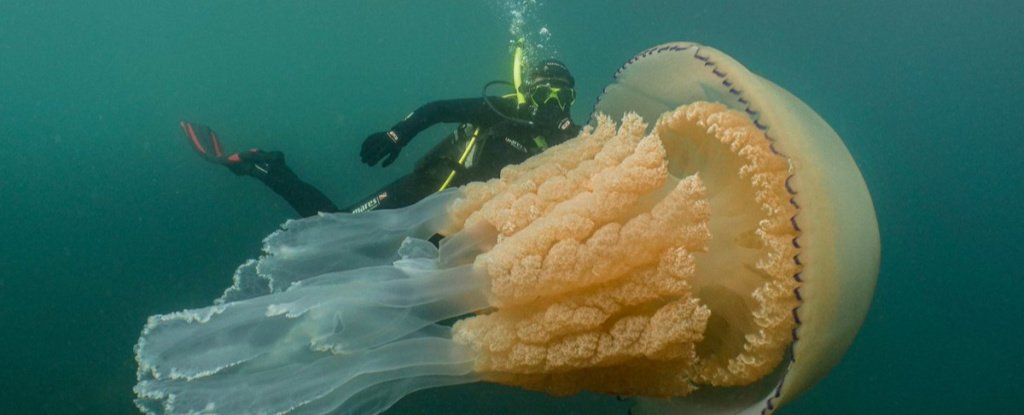It’s How Big?? Divers Discover Massive Jellyfish

Many people enjoy going scuba diving as part of a holiday in places like Greece, the Caribbean and Mexico.
Swimming with sharks, swimming with dolphins; these have become popular activities in many warm, seashore destinations, and even folks who’ve never before been near the ocean love diving beneath its surface to catch a glimpse of colourful reefs and oddly colored fish.
It’s only a lucky few, relatively speaking, who get to go diving for a living, and U.K. biologist and broadcaster Lizzie Daly is one of them.
When she and her cameraman, Dan Abbott, went diving this past summer as part of Wild Ocean Week, they swam upon a unique critter that caused them both to do double takes under their masks: a massive jellyfish, of the breed Barrel Jellyfish.
They had been shooting footage of creatures as part of a campaign to raise both funds and awareness for the Marine Conservation Society of the U.K.
The creatures do grow quite big, Daly told the Washington Post in July, but the one she and her partner saw was a rarity, as big as a person, and they have the video footage to back up their claim. “We weren’t expecting anything. It was an absolute delight to get that experience.”
The pair went diving off the coast of Cornwall and were almost finished shooting for the day when they came upon the beast.
Woah!!!!! We went diving in Falmouth yesterday to finish off #WildOceanWeek and came across this GIANT barrel jellyfish! ? What a way to finish off this marine wildlife adventure! ? pic.twitter.com/NNwDelfWyV
— Lizzie Daly (@LizzieRDaly) July 14, 2019
Although it’s actually quite a benign animal that would not hurt anyone — unless provoked, that is. “They don’t really pack a mean punch,” Daly insisted, but acknowledged that, “…I wouldn’t want to put my hand in there.” By “there,” Daly is referring to the numerous tentacles jellyfish have to trap, sting and immobilize their prey, usually small fish and plankton.
Cheryl Ames, of the Smithsonian National Museum of Natural History, who is a colleague of Daly’s, confirmed the unique sighting, and told the Post, “it’s really incredible to see them this big.”
Abbott agreed wholeheartedly. “My first reaction was that I’ve never seen a jellyfish that big in my life,” he admitted, and said he was a little cowed by the experience.
But he was determined to get footage that relayed the size of it, but wanted to film the “beautiful, majestic, slow moving, graceful animal,” as he described it. Watching the film he shot, one can only agree that Abbott captured the jellyfish’s size, scale, and style of swimming perfectly.
While the pair’s barrel jellyfish may well be an amazing specimen, unfortunately jellyfish are one of the most invasive species in waters all around the world, causing havoc to fisheries, wiping out habitat for indigenous species, and destroying food supply for marine life everywhere.
They tag along in the ballast of ships, and when that water is emptied in a port, so are the jellyfish, in an unfamiliar environment to which they readily adapt.
The fishing industry in the Black Sea was almost destroyed in 1983, when the comb jellyfish arrived from America’s Atlantic region. Before officials even realized what was happening, fisheries lost more than $1 billion (USD) because the jellies destroyed the balance of the healthy aquatic environment, and even affected the oxygen levels in the water. Soon the comb jellies were overtaking the nearby Azov Sea as well.
Join @LizzieRDaly @SwanseaUni this #bankholidayweekend for the LARGEST Jellyfish survey in the UK. Pop along to your nearest beach, snap jellies and enter your finds into the @mcsuk website- Its THAT easy!
Follow @GBJellywatch share & tag your Jellyfish snaps #GBJellywatch pic.twitter.com/DnEjk41wRy— College of Science (@swanscience) August 20, 2019
But America was plagued by them first; the Australian comb jellyfish invaded its Atlantic coastal waters in 1981 and decimated the fishing industry and marine life there.
So, although America passed the comb jelly to the Black Sea, it was first brought to its shores by ships, and then carried to other ports. It is this kind of cyclical invasion that makes control of foreign species so difficult for all jurisdictions.
And jellyfish are far from the only invasive species causing problems in oceans and other water systems around the world. Canada’s Great Lakes — Ontario, Huron, Erie and Superior — have been inundated with zebra mussels that arrived as hitchhikers on the hulls of ships as they passed through shipping lanes like the Saint Lawrence Seaway.
They thrive in virtually any temperature, and because female zebra mussels lay approximately one million eggs every cycle, it has become virtually impossible to eradicate them.
But for Abbott and Daly, those issues are not a priority; their job is to raise awareness of the beauty of marine life, and the magnificent creatures that swim just below the surface.
Daly, in particular, is hopeful that their footage of the Barrel jellyfish will encourage others to check out what might be living in their neighbourhoods, just below the surface.
You can also follow Lizzie on Twitter and Facebook
Another Article From Us: Found in Permafrost: 2,300-Year-Old Cabin Rebuilt
“Get in the water,” she urged, “grab a snorkel and mask, (and) just go for it to see what’s there.” One might not spot a massive Barrel jellyfish, but no doubt the splendid colours and sights of the sea are enough to make a fan of even the most reluctant swimmer.
